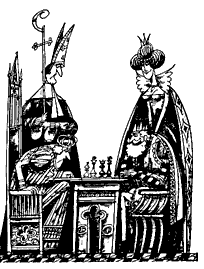 20. KNIGHT’S MOVE
20. KNIGHT’S MOVE 
In chess, the knight moves (to the red squares) with a ‘two and one’ motion as illustrated in the diagram at right. So in a single move, the knight on square 13 could move to any one of the squares 2, 4, 20, 24, 22, 16 or 6.
An old question concerns the so-called ‘knight’s tour’. Is it possible for the knight to begin at the central square (13) and travel around the 5 x 5 board visiting each remaining square exactly once?
You may be able to find the answer by trial and error. However, it is more interesting to ask whether somehow the problem can be simplified, so that we can see more easily what is happening.
Now, what squares are possible endpoints for a successful knight’s tour?


Hint 1
It is always a good idea to try to simplify a problem. Sometimes, as here, it is helpful to move the difficulty!
Hint 2
In the present situation, the board is nicely arranged, but the knight’s move is awkward. Perhaps we could replace the board by a new figure of 25 squares in which any square which a knight can reach in one jump is seen to be adjacent to the knight’s present square?
Solution
Let us rearrange the squares so that the possible successive squares in the knight’s journey are connected by a line segment. With a little juggling we can obtain the figure below.
 .
.
It is now a trivial matter to pick out a possible knight’s tour. For example, we could take 13, 10, 19, 22, 11, 2, 9, 20, 23, 16, 7, 4, 15, 24, 17, 6, 3, 12, 21, 18, 25, 14, 5, 8, 1.
The only possible endpoints for the knight’s tour are the midpoints of the edges of the outer square. For if this does not occur, then during the tour the numbers in the outer square must be visited in edge triples, such as
(18, 25, 14). But it is impossible for all four edge triples to occur in this way without a repeated vertex number occurring. Hence the tour must end in one of the midpoints: 1, 5, 21, 25.
Extensions
Experiment with boards of different sizes, from 4 x 4 up to 8 x 8.
Hint 1
Hint 2
Solution
Extensions



 .
.